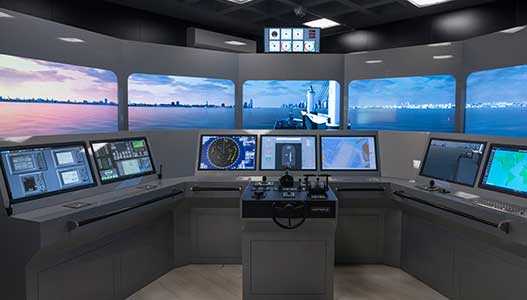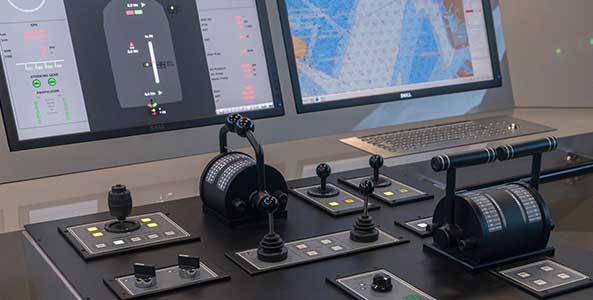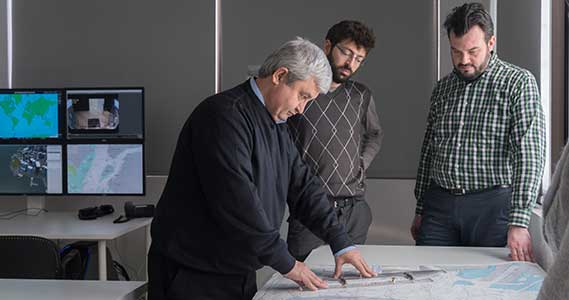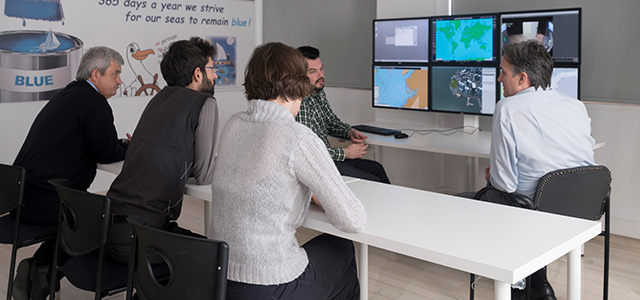Introduction
In today’s demanding environment, deck officers are expected to be well prepared to address the more complex regulatory regime while steering their vessel safely, securely and in an efficient and environmentally friendly way.
They need to manage operational risks, deal successfully with adversities and maintain proper attitudes within the bridge team.
Consequently, companies should ensure that new Masters, watch officers, chief officers and cadets are well-versed in the new technologies on the bridge and are able to interact in the best possible way with the other officers and pilots as well as with the equipment, on routine and emergency situations.

So, we urge our Member companies to take advantage of the new Simulation Training HELMEPA is now offering and advance the competence of their deck officers providing them with the opportunity to acquire useful skills in a realistic bridge setting.
The association in its capacity as "Maritime Training Center for Pollution Prevention, Safety at Sea and Environmental Awareness" according to ISO 9001:2008 Quality Standard, is offering to its Members refresher training on a "NAUTIS Full Mission Bridge Simulator" kindly donated by Associate Corporate Member DNV GL, in appreciation of the voluntary training HELMEPA has been offering to its Members for 33 years.
The Simulator
It is a NAUTIS Standard Class "A" Full Mission Bridge Simulator compliant with DNV GL Class "A" FMBS specification based on STCW 1978 including the 2010 Manila Amendments.
The high quality 240° horizontal field of view ship bridge replica simulator is certified as per the Standards for Certification No. 2.14 for Maritime Simulator Systems and IMO model courses 1.22 and 1.32. It provides true to life simulation training as it includes GPS, AIS, Echo-sounder, Speed Log, VDR, RADAR, GMDSS, VHF Communications, Ship Control and Conning Display and ECDIS.
Its vessel data base has a variety of types and sizes of vessels up to 238,000 grt with lengths up to 318 meters, breadth 47 meters and draught 18 meters.


Instructors
Instructors of HELMEPA’s simulation courses are experienced former Hellenic Navy deck officers, specially trained and certified in accordance with the STCW Requirements and IMO Model Courses 1.22 and 1.27 for BRM and ECDIS respectively.
Courses
HS1 - "Bridge Resource Management" (5-day)
The Cyprus Maritime Administration approved HELMEPA’s BRM Course. Deck officers who will attend it may obtain the official BRM Certificate by applying to the Cyprus Maritime Administration.
The certified course is a 5-day one and consists of 19 topics presented in 40 hours in total, as the following table shows:
HELMEPA BRM Course (HS1)
Approved by Cyprus Maritime Administration
|
Topic |
Duration (Hours) |
|
|
Knowledge, Understanding and Proficiency |
Lecture |
Simulation |
| 1. Review of the Basic Principles as per STCW A-VIII/2, including charts’ datum - position fixing - radar principles - parallel indexing - commonly used Nautical Publications - principles of effective Passage Plan preparation, implementation and monitoring | 2 | 0 |
| 2. Familiarization with HELMEPA’s simulator bridge equipment, systems, capabilities and limitations | 0 | 1 |
| 3. Standard Maneuvers: vessel’s turning circle and affecting factors – vessel’s pivot point and various maneuvers – suitable use of rudder and engine(s), kick ahead - crash stop – keeping records – updating ship’s pilot card and other | 0.5 | 2 |
| 4. Wind and Current Effects: wind and pivot point – windage area – wind and use of tugs - executing turning circle with wind and/or current. - wind and/or current effects on vessel’s turning circle- exploiting positive wind or current effects and minimizing negative effects | 0.5 | 2 |
| 5. Attitude: recognizing, understanding and improving crew’s attitude and behavior in order to erase possible differences – establishing and nurturing cooperating spirit in all aspects of working and living together onboard ship | 1 | 0 |
| 6. Cultural Awareness: understanding, recognizing and respecting differences/similarities of culture among crewmembers with the aim to avoid offenses and improve coexistence, cooperation and human relations onboard. | 1 | 0 |
| 7. Briefing and Debriefing: the importance of briefing and debriefing of all members of bridge team before departure and upon completion of voyage will be stressed so that most optimum and constructive involvement of all team members is achieved – same with pilot’s effective briefing | 1 | 0 |
| 8. Challenge and Response: the importance of establishing good communication among bridge team members and between bridge team and master and/or other involved personnel onboard as well as the establishment of clear orders regarding coping with unforeseen or emergency situations will be analysed and underlined | 1 | 0 |
| 9. Shallow Water Effects on vessel’s maneuvering ability – squat and factors affecting squat - effects of Squat on vessel’s draft, trim and maneuvering | 0.5 | 2 |
| 10. Bank, Channel and Vessel to Vessel Interaction Effects: cushion, suction, ship to ship interaction etc. | 0.5 | 2 |
| 11. Planning: passage planning, anticipation of risks and preparation of relevant emergency plans to cope with emergency situations | 1 | 0 |
| 12. Authority: the importance of balance between authority and assertiveness. management and leadership. | 1 | 0 |
| 13. Management on the Bridge: management style, balance between good performance and best handling of human resources - ability to work with managers of different style | 2 | 0 |
| 14. Workload, Fatigue and Stress: knowledge and good estimation of expected workload - work and duties effective planning, fatigue anticipation, delegation of responsibilities, setting priorities, clarifying roles of bridge team, towards reducing and sensibly distributing workload and avoiding or minimizing stress generating factors | 2 | 0 |
| 15. Anchoring and Single Buoy Mooring: planning and organizing anchoring or single buoy mooring - factors to be taken into account - best practices of implementation, methods of anchoring, stressing out important points | 0.5 | 2 |
| 16. Human Factor in Error: error chain - recognizing of error chain signs - suitable intervention to break error chain - master’s initiatives for applying best bridge resource management - learning from errors - use of lessons learned to avoid re-occurrences | 1 | 0 |
| 17. Decision Making: gathering of information – assessing and compiling information – best situational use of information and inputs – master’s response – right contribution of the bridge team and pilot to assist the master to make a decision | 1 | 0 |
| 18. Crisis Management: master’s role to best cope and manage with crisis situations in a calm, firm and most suitable manner, clearly allocate roles and best use means available, coordinate actions to avoid panic and successfully overcome the crisis - importance of adequate and effective planning, training and practicing towards best coping with crisis situations will be underlined | 2 | 0 |
| 19. Planning and executing voyage under normal and emergency conditions: passage plan preparation, execution and monitoring - ship’s preparation for sea - use of check lists, ship’s maneuvering information - correct communication with VTS and shore authorities, services and facilities - complying with COLREGs - suitable and appropriate bridge watch keeping shifts and arrangements | 1.5 | 9 |
HS2 - "Advanced Ship-Ηandling and Navigational Safety" (3-day)
A 3-day seminar with 7 hours classroom presentations, where trainees refresh and enrich their knowledge on BRM principles and how turning cycle characteristics, hull dimensions and shape, draft, current, tides, engines, rudders, thrusters, anchors, shallow waters, squat, banks, channels etc, affect the handling of the vessel. In 14 hours simulator practice (exercises) in a realistic but consequence-free environment, trainees learn to handle the vessel under the effects of combined forces like engines, propellers, anchor's strain, thrusters, currents, wind and tides.
They get the "feeling" of handling the vessel before they do it in real terms and they maneuver it experimentally in mooring, un-mooring, getting alongside, anchoring, SBM and other scenarios. The seminar is for deck officers of all ranks, useful also to BRM Certificate holders, covering also BRM refresh requirements.
The seminar covers topics of the Model Course 1.22 of IMO (BRM) as well as of ship-handling as follows:
- Teambuilding and teamwork
- Building positive attitude of cooperation
- Leadership and decision-making
- Resource management
- Management of operational tasks
- Danger of stress
- Attitude and risk management
- Safe watch keeping
- Bridge organization and management
- Handling of various types of ships
- Role of Pivot Point
- Wind, current, squat and banks effects
- Under Keel Clearance
- Passage Plan and contingency plans
- Maneuvering Systems
- Emergencies on a ship-man overboard
- Approaching the Pilot Station
- Navigation with Pilot on board
- Ship-Ship Interaction
- Ship-Tug Interaction
- Berthing and Unberthing
- Anchoring
HS3 - "Navigating in Dense Traffic - Fishing Areas - COLREGs and Loss Prevention" (2-day)
A 2-day seminar with 6 hours classroom analyzing to trainees rules of the road PARTS Band C, with the use of suitable overheads and animations in interactive and highly comprehensive ways.
During 8 hours of simulator training, participants practice in right COLREGs implementation, safe navigation and collision avoidance in dense traffic and / or fishing areas under various weather conditions. Aiming at enhancing loss prevention mindedness, real case studies of marine incidents/accidents are also presented, analyzed and simulated. The seminar is for deck officers of all ranks, and also for deck cadets.
The following topics are covered:
- Bridge Team - Bridge resources optimum performance. Realizing capabilities and limitations.
- Master - Officer of the watch - Bridge team roles and most effective cooperation. Calling the Master on the Bridge.
- Lookouts active role in assisting O.O.W.
- Pilot on board and his integration in Bridge team
- Transfer of the watch principles and best practices.
- COLREGs Parts B and C. Best practices in implementing COLREGs.
- Using all means to get best - most favorable to each situation, vessel's maneuvering.
- Rudder response - Speed change over time
- Wind, current, squat and banks effects on ship handling
- Maneuvering the vessel in extreme circumstances
- Navigation in dense traffic and fishing areas.
- Bridge equipment and officer's response to malfunctions
- Ship-Ship Interaction - Close quarters situations.
HS4 - "Real Incidents’ Simulation and Root Cause Analysis" (2-day)
A 2-day seminar presenting, simulating and analyzing real marine incidents taken initially from existing relevant official sources (MAIB, CHIRP,MARS etc.), and then also from the Voluntary Near Miss Reporting Scheme as it progresses.
Cases will be presented and discussed and then simulated as per developed scenarios that are reconstructing the incidents based on reports as above. Further discussion on the incident will follow and lessons learned will be concluded.
HS5 - "Encountering Heavy Seas: coping with Head, Beam and Following and Quartering Seas" (2-day)
A 2-day course presenting and explaining the Surface Analysis and Upper Layer 500 mb Charts and providing information on Tropical Revolving Storms as well as Mid-Latitude Cyclones. Emphasis will be given on avoidance tactics to be followed. Ship’s behavior on Head, Beam and Following/Quartering Seas will be explained in theory and in practice, highlighting the tactics to be used to avoid the included dangerous phenomena, whilst particular analysis will be provided on Synchronous and Parametric Rolling. More specifically, the course includes the following
Day 1: Heavy Seas Avoidance
- Use of Surface Analysis Charts
- Use of Upper Layer 500MB Charts
- Tropical Revolving Storms (Hurricane, Typhoons, Cyclones etc in the Tropics) and avoidance
- Mid- Latitude Cyclones and avoidance
- Simulator: Sailing in Heavy Seas under low visibility
Day 2: Encountering Heavy Seas
- Ship behavior in waves (Ship’s Natural Rolling Period – Encounter Wave Period)
- Head Seas: Propellers’ Racing, Speed reduction and torque rich effect on the engine, Shipping Seas, Pitching and Slamming Phenomenon
- Beam Seas and Synchronous Rolling
- Following and Quartering Seas: Encountering Wave Grouping Phenomena, Surf Riding and Broaching-to, Reduction of ship’s Stability, Pooping
- Synchronous Rolling
- Parametric Rolling
- Simulator: Sailing in Heavy Seas under low visibility
Participation - Donations
Deck officers, of all ranks, are eligible to attend the seminars. The maximum number of participants in each course is 8 officers.
In order for HELMEPA to cover part of the necessary cost for the simulator's operation and continuous update, Members are kindly requested to pay per participant, in the form of donation:
- HS1 - BRM €250
- HS2 - Advanced Ship-Ηandling and Navigational Safety €150
- HS3 - Navigating in Dense Traffic - Fishing Areas - COLREGs and Loss Prevention €100
- HS4 - Real Incidents’ Simulation and Root Cause Analysis €100
- HS5 - Encountering Heavy Seas: coping with Head, Beam and Following and Quartering Seas €100
Non HELMEPA Members may participate in the Bridge Simulator Seminars, provided there is availability, against a donation per person of:
- HS1 - BRM €500
- HS2 - Advanced Ship-Ηandling and Navigational Safety €300
- HS3 - Navigating in Dense Traffic - Fishing Areas - COLREGs and Loss Prevention €200
- HS4 - Real Incidents’ Simulation and Root Cause Analysis €200
- HS5 - Encountering Heavy Seas: coping with Head, Beam and Following and Quartering Seas €200





